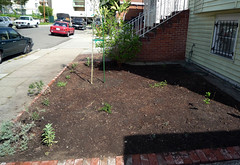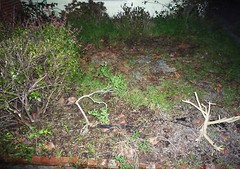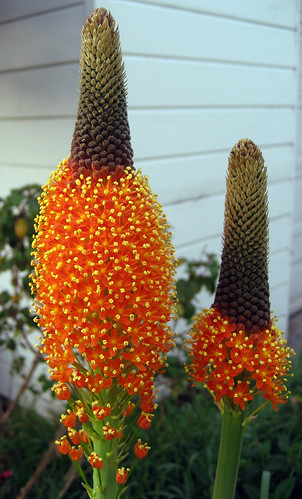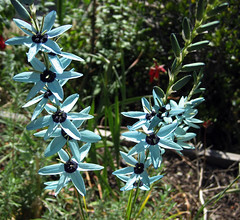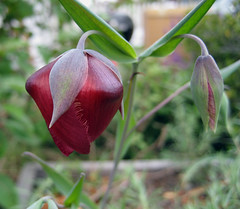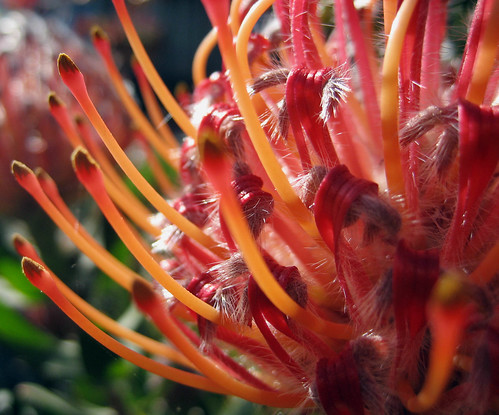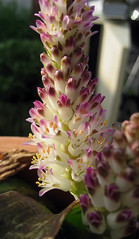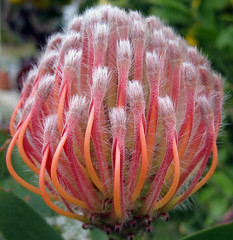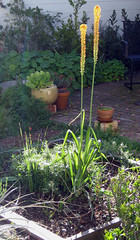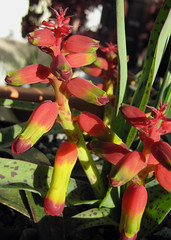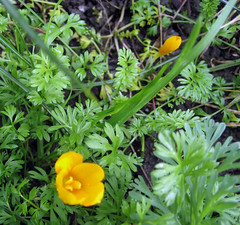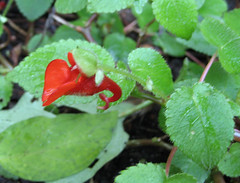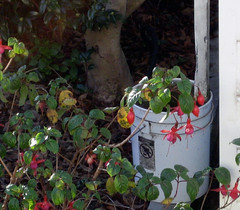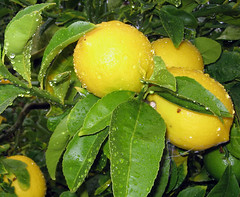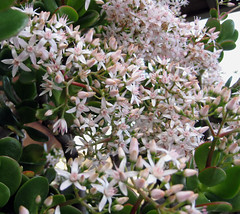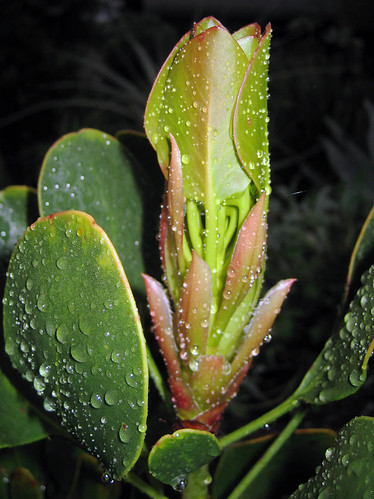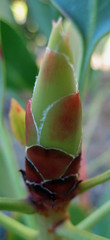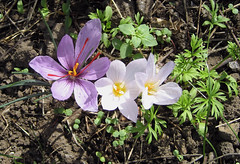18 January 2012
13 November 2011
Another List
05 November 2011
Another List
04 November 2011
Whoa
25 March 2010
Mission accomplished
20 March 2010
02 February 2010
help
For various reasons, an olive tree is going to be the main feature. I might even be crazy enough to plant a fruiting variety, and make my kids cure olives for me when they get older. Four is good age to start working with lye, right?
Around this olive I wish to plant a kind of mini-garrigue, mostly of subshrubs and annuals. The plantings will be artificially dense in a vain attempt to suppress the weeds, and require no summer water. Thus: mediterranean-climate plants. It would be nice if it looked "good" in a front yard kind of way year-round.
I want a limited color palette of blues, whites and yellows, though lavender will be involved, by decree from on high (my wife) -- I will probably stick with L. x intermedia cvv. I'm also into Eriogonum latifolium and E. umbellatum; Penstemon heterophyllus and maybe palmeri. Sisyrinchiums. Salvia chamaedryoides, open to suggestions for California natives. For annuals, I'm looking at the usual suspects from Larner Seeds.
A spiky Phormium would be so sweet in here! Sorry, no: mediterranean only, dude. I'm considering (Hespero)Yucca whipplei or various Aloes or even Watsonias. Nothing too sharp: I don't want my kids to lose an eye (I've got a Puya out back for that purpose). However, anything to discourage the cats from shitting therein is a plus.
So what should I plant? Something I HAVE TO TRY? Something I listed a boondoggle? Crowdsource my yard!* Before you jump in, consider these limitations:
- approx. 17x15"
- north-facing: FULL sun all summer, total shade all winter
- soil is clay, but with decent drainage
- this is Oakland, CA coastal sage scrub, zone 10A (alleged)/Sunset 17
*ironic. but srsly., please help!
Labels: comparative gardening, crowdsourcing, help
04 February 2009
20 January 2009
Happy New Year!
This is the space where one apologizes for not blogging, based on the pathetic fallacy that you care (technically, the fallacy is that the addressee, "you", even exists; the imputation that "you" care is just an icing of presumption on the fallacious cupcake). But I'm kind of over that, and the point is to alert "you" that Bob Nold has a blog, which will be infinitely more interesting than anything I write.
Everyone probably knows this already (sorry, I don't have time to read "your" blog either), he's been writing it for six months now. I'm so out of it I didn't even figure it out when he commented here in June.
Thanks Timber Press! Now how about a copy of that Aquilegia book?
Labels: Bob Nold, Gardening and telecommunication
04 September 2008
Battlefield
In this photograph I managed to capture Agavaceae, Asphodelaceae, Haemodoraceae, Iridaceae, Plantaginaceae (formerly Schrophulariaceae), Polygonaceae, Proteaceae, Ranunculaceae, Rosaceae, Rutaceae, and Themidaceae. Plus some weedy Poaceae. Probably no one else is schizophrenic enough to cram all that into a such a small area.
But that was not the point. Earlier this summer I thought about writing something about Polygonaceae, in the form of Eriogonum grande var. rubescens, the little balls the color of cheap nail polish pictured in the middle ground, and esp. E. latifolium, which I seem not to have photographed. The latter is the color of dirty laundry from afar, but close up reveals subtle whites, grays and roses wonderfully arrayed. The point of these plants isn't the flowers anyway, but beneficial insects who love it, and especially the felty leaves, which shame the hideous "lambs' ears" (Stachys something or other) so beloved of landscapers. I spent at least a few minutes coveting a yard comprised solely of Agaves and Eriogonums, in my first ever minimalist fantasy.
That wasn't the real point either, it was that on my now extremely infrequent trips out back, Skippy the resident Anna's hummingbird is invariably to be found enjoying the orange-trumpeted plant in the foreground, which used to be called Zauschneria californica, but is now Epilobium canum ssp. canum (cv. Catalina pictured). Tonight Skippy was unamused, and really shamefully inhospitable when a Rufous hummingbird stopped by, and some rather spectacular aerial combat unfolded before my eyes and occasionally a few feet from my head. Of course the camera was inside, but Skippy was still there when I came back later. You win zero dollars if you can find him in this picture (go to Flickr for the original size). And don't even try to find all those plant families, half of them appear only as straw.
21 May 2008
The Ides of May
I looked into the name of D. ida-maia a few years ago, and read somewhere that it was named after a lady named Ida Mae. But I was never totally satisfied with this explanation, because it always blooms on May 15, which is the Ides of May, a date newly significant to me. So with the help of the internets, I tracked down Alphonso Wood's original 1867 description of what he called Brevoortia ida-maia:
This plant was first noticed by Mr. Burke, stage-driver, in his daily route, and by him my own attention was first called to it. He had given it the name of "Ida May, in affection for his little daughter,"—a name quite appropriate, moreover, as on the Ides (i.e., the 15th) of May, the plant begins to flower.
The type locality was on the stage road from Shasta City to Yreka.
Labels: babies, California, Dichelostemma, Ides Maiae, Ixia viridiflora
08 May 2008
Natives
Also: fairy lantern!
2: If you liked reading about the Presidio manzanita, you'll love this unnamed species.
Labels: Calochortus, manzanita
07 May 2008
My new favorite article title
A. C. Gaskett et al., "Orchid Sexual Deceit Provokes Ejaculation," American Naturalist 171 (2008).
They're talking about pollinators, not orchid collectors.
Go ahead, read it, it's (allegedly) free.
01 May 2008
The importance of being earnest
A certain blogger recently recommended buying ladybugs to release in your yard for pest control. I don't want to single out this endearing and admirable person, but this is a perfect example of making things worse by trying to make them better. A little bit of research, not to say common sense, would reveal that kidnapping bugs en masse and selling them to gardeners is not a good idea.
 This is what is so dangerous about the current "green" climate in America: it can easily do more harm than good, as with ethanol, which, if you weren't paying attention, is currently responsible for starving the developing world, consuming more energy than it produces, and the rising prices you're paying for gas and food.
This is what is so dangerous about the current "green" climate in America: it can easily do more harm than good, as with ethanol, which, if you weren't paying attention, is currently responsible for starving the developing world, consuming more energy than it produces, and the rising prices you're paying for gas and food.
So if you're going to do something -- especially if you're going to publicly advocate doing something -- to make the world better, make sure it will actually make the world better.
[Brendan I. Koerner's Green Lantern column at Slate is an interesting attempt to do this.]
Labels: earnestness, green, RTFM
17 April 2008
News
10 April 2008
02 April 2008
Travel
We also flew over Elba, Skye, Iceland, and Victoria Island, a lot of interesting islands for a single flight. Except for Elba, they all looked deserted from the air.
On the ground, I did manage to duck into the orto botanico, a pleasant enough oasis, but botanically rather staid in the afternoons, when the greenhouses are closed.
Labels: don't eat the "british breakfast", I'm actually relieved that I may never travel again, islands, Kew, Lachenalia, Naomi Cambell, Rome, Terminal 5
25 March 2008
Just in time
As I get ready to leave town, a flurry of activity, of course, including the first bloom of my Leucospermum 'scarlet ribbons'. It hasn't really opened yet, and I was going to wait to photograph it, but I just couldn't resist because it is so AWESOME. The plant is literally covered in flowers.
Don't worry, I've got some more treats in reserve that will probably open when I'm gone.
Labels: awesomeness, esunmilagro, Leucospermum, pincusion, Proteaceae, spring
14 March 2008
Further excitement
At this point, Clivias, or at least Clivia miniata cultivars like this, don't seem particularly exotic to me. Even growing by the sidewalk. But I grew up with a Clivia (eventually many, many Clivias) that my mother babied for years and years before blooming. So it's not something that I take for granted, even now. Especially since this bloom is on a potted specimen I just bought last year, not the plant in the ground.
The first Freesias opened recently, I'm not sure exactly when because I've been so preoccupied with the Calochortus that I didn't notice, until I was out hunting snails by flashlight, suddenly blinded by the reflection off these (those LED lights are bright!). F. alba seems to be very happy, as these are a lot bigger than last year.
*
But the most exciting news of the day is the reopening of Pacific Rim Nursery whose demise I lamented only a year ago. Now, if only I hadn't pauperized myself (and the dollar hadn't shit the bed) in the intervening year!
Seriously, though:
Paeonia cambessedesii or Paeonia mascula subsp. arietina?
Labels: Calchortus umbellatus, Clivia, Freesia, Hillkeep, Paeonia, peony, spring
09 March 2008
Sweet box
This seemingly precocious spring has induced my first flower of Calochortus umbellatus. The Oakland star tulip is the flower that started it all -- if by "it" you mean my madness. I read about this lovely little bulb and decided that I should plant some, mostly because of the name: it is the only plant I know named after my town. Although apparently even the holotype is from somewhere else. There is no there here. At least part of my reasoning was that it would probably grow well here, being native and all.
But it was not easy to come by, oh no, and thus began my odyssey into the world of rare bulbs and mail order seed and various other obsessions, until I finally obtained some bulbs last fall (Thanks Telos and Far West!). And now my first diminutive and truly beautiful flower has opened.
It is much more subtle than the things that usually appeal to me. Also, admittedly, kind of purple: the petals are flushed a -- delicate! -- mauve purple, and the wonderfully contrasting anthers can at best be called blueish. Nevertheless, I will call them "blue steel".

This first bloom is a mutant: 8 tepals, but the normal 6 stamens. I wish I wasn't an idiot as a child and had learned something about science, because the genetics of the MADS box genes that control these things would be very interesting if I understood it.
Labels: blue steel, Calchortus umbellatus, Gertrude, MADS box, represent, spring, sweet box
06 March 2008
Excitement

Labels: Brunsvigia, Seneca Hill, South Africa
04 March 2008
Triumph
I have also managed to germinate Lilium bolanderi. I did at least know that this would be hard, so when I got the seed last winter I stratified half of it for about 8 weeks, and kept the other half in the freezer until I sowed it in October. Leaves appeared for the first time in each pot last week (at the same time as some L. pardalinum I treated the same as the first batch).
Conclusion: let nature take its course. I did probably get lucky with nature this year, as we've had 831 chilling hours so far this year, nearly twice what I take to be average. L. bolanderi lives higher and further north from me and so is probably accustomed to much more winter chill, not to mention snow cover.
Now to try not to kill it this summer.
Labels: Bulbinella, chilling hours, Lilium, seed, triumph
26 February 2008
Seed in the news
Why, amid the self-congratulation suffusing media accounts of the global seed bank in Svalbard, does it require a "radical" NGO to point out the problem? You don't get a prize for destroying the world's crop diversity, then saving a tiny sample in the freezer.
20 February 2008
Common
Now that it's started raining again, I can report that while it was sunny, Bulbinella latifolia and this Lachenalia rushed into bloom along with the crocus I mentioned. By the way, I have been castigated for not using common names, but does it really help you to know that the Lachenalia is called a "cape cowslip"? The Bulbinella doesn't even have a common name, as far as I know... When I started this, I didn't know shit about plants, so I made a point of learning their real names to be sure what I was talking about. But so many plants that grow here either have no common name, or a fake common name, or a common name that is meaningless to those of us who live continents away from its habitat, that it wouldn't make sense to use them even if I wanted to.
Anyway, the sun allowed me to inspect my seeds further. No sign of life yet from the Fritillaria recurva, but I haven't quite given up hope yet -- there are a few sign of life in the long-abandoned Penstemon grahamii pot, of all places; probably weeds, but you never know. And much to my surprise, I successfully germinated Castilleja applegatei var. pinetorum: common, nay, vulgar name "indian paintbrush" (and unlike I. niamniamensis, it memorializes nothing but stupidity). The hard part is apparently not germination (not if I can do it), but getting them to grow: it is a hemiparasite. No one knows what the host species is (are?).
All Castillejas are parasites by the way. They've been transferred from the Schrophuliariaceae to Orobanchaceae. Commonly called, as those of you who profess to value such names will be dismayed to learn, "the broom rape family."
Labels: colonialism, Lachenalia, names, seed
06 February 2008
Naivete, i.e., stupidity
And it would be a cute combination, if Crocus gargaricus bloomed in the fall like the others.
In it's native... Turkey? this Crocus apparently blanket fields in its inimitable gold, creating quite a spectacle. Good thing I bought 3 of them!
Another surprise was a profusion of flowers on an Impatiens nyungwensis that had done nothing since I planted it months ago. Makes up for losing the I. niamniamensis, presumably to cold. It wanted too much water anyway.
The excitement of last year's alliums finally germinating was similarly tempered by the failure of my Fritillaria recurva to do anything. (You'll recall I bought seeds from four different populations last year, and had [vain]glorious visions of breeding the ultimate frit). I haven't completely given up yet, but I'm getting seriously worried. They must have dried out too much over the summer. The prospect of starting over is discouraging.
17 January 2008
Conservation
I think I last turned the compost in October?
Our last burst of rain brought us to around 10 inches for the year, which is pretty good, but still less than half of the "average" we'd like to get. One of the obvious ways to supplement the water supply is is to capture the runoff from your lot. More than half of the rain that I "get" washes out immediately to the street, storm drains and the bay. It would be nice to divert all of this into a massive cistern under the garage and water the garden with it all summer, but that is very, very far down the list of things I can't afford to do. So instead, I run the garage downspout into this 5 gallon bucket, which I empty into my unmortared brick patio whenever I'm not too lazy. Plus, it's so attractive.I've been congratulating myself on this homespun groundwater recharge technique for a few years, but I decided to run the numbers (because I don't have enough to do), and every 20x I empty the bucket seems to equal an additional .1608 inches when spread over the whole garden. Revolutionary!
Of course, my math is probably wrong anyway.
Great, that photo just reminded me I need to prune the Fuchsia.
PS: California nativists might want to note the impending closure of Henry W. Coe state park, which displays its impressive collection of flora on an excellent website.
Labels: ask me about the weather, bukkit, maths, OMTFG, rain, self-congratulation
07 January 2008
Springtime
The "storm" was negligible here, but we got a nice accumulation of ~3.5 inches, which I figured out no thanks to the NWS, which has apparently abandoned its bay area weather stations. I also learned that we've had 400+ chill hours already this year, twice normal, which explains why my @#*! gas bill is so ridiculous, but not why the 'Double Delight' rose is still blooming when I should be doing its dormant pruning.
*
Anyway, although html tables aren't the best place to keep track of my germination rates, I'm too lazy/stupid to use Excel, so you can stop reading now. Unless you too are a huge dork. All from Northwest Native Seed.
| sp. | AN | soak | strat. | germ. | Notes | ||
|---|---|---|---|---|---|---|---|
| Calochortus bruneaunis | NNS 05-121 | 1/6 | 1/7-2/5 | 2/3 | |||
| C. dunnii | NNS 04-65 | 1/6 | 1/7-2/16 | 2/15 | |||
| C. howellii | NNS 05-136 | 1/6 | 1/7-3/8 | y*** | |||
| C. invenustus | NNS 05-137 | 1/6 | 1/7-3/8 | y | |||
| C. simulans | NNS 05-155 | 1/6 | 1/7-1/27 | ~1/26 | |||
| C. striatus | NNS 05-157 (2) | 1/6 | 1/7-1/20 | ~1/18 | |||
| C. venustus | NNS 05-171 | 1/6 | 1/7-2/5 | 2/3 | |||
| Dicentra formosa ssp. oregana D* | NNS 07-159 | 1/6 | 1/7-3/8 | almost?! | 3/8: seed coat split and radicle visible, though not yet emerged | ||
| Dicentra formosa ssp. oregana W* | NNS 07-159 |
| n/a | [potted up 1/20 because of apparent mold on elaisosomes] | |||
| Castilleja applegatei var. pinetorum** | NNS 06-120 | 1/7 | 1/8-3/8 | y | |||
| Dodecatheon poeticum** | NNS 07-169 | 1/7 | 1/8-3/8 | ? (too small) | |||
| Fritillaria biflora | NNS 05-345 (2) | 1/7 | 1/8-3/8? | 1 | |||
| F. eastwoodiae | NNS 07-250 | 1/7 | 1/8-3/8 | y | |||
| Ipomopsis aggregata var. aggregata | NNS 07-277 | 1/7 | 1/8-3/8 | y | |||
| Lilium rubescens x L. bolanderi | NNS 06-338 | 1/7 | 1/8- | n | |||
| Lupinus microcarpus var. densiflorus | NNS 03-405 | 1/7 | 1/8-1/17 | ~1/14 | |||
| Penstmon labrosus | NNS 05-548 | 1/7 | 1/8-2/5 | 2/3 |
** damp sand in ziplocs; too small for paper towel.
21 December 2007
Solstice
I also avoid the garden blog bloom day thing because this entire blog is about what's blooming in my garden. I don't need a special day for it.
Anyway, when you live somewhere buried under a couple feet of ice this time of year, you imagine that all you want is a little bit of winter color. And the lemon tree does fulfill that role admirably. But when you live here, you still want flowers, because you're an unsophisticated philistine who can't be content with the timeless grace of foliage when there's shiny sex organs to display. Those of you in colder climes might not be familiar with the flowers of the Jade tree, which looked like this in my neighbor's yard this morning. Yeah, I said tree: it's about 8 feet tall.Anyway, when I was poking around this morning, I have to admit it suddenly hit me how amazing it is to have so many things blooming on the shortest day of the year: Abutilon, Bougainvillea, Brugmansia x candida, Fatsia japonica, Fuchsia, Gardenia [!!11!], Impatiens niamniamensis (ok, that finally dropped its floweres and looks pretty sad, but I swear it was blooming last week), the lemon tree, Passiflora manicata, a bunch of Salvias and the awesome Satureja mexicana that never stops flowering, Silene, Zinnias (still, though they look like crap now)... How lucky am I?
Not lucky enough, it turns out, to have a Protea flower yet. I got a little carried away by what is actually a bunch of leaves (though in my defense their hirsute emergent leaf margins look a lot more like nascent bracts than the glabrous mature leaves):
Labels: lemon, premature jubilation, Protea cynaroides, solstice, winter
12 December 2007
Hello world
Have you noticed that it's cold? Hella cold, actually. Not, of course, the oh-shit-I-might-die-if-I-go-outside cold of the rest of the country (much less the the oh-shit-I-might-die-anyway-if-they-don't-turn- the-power-on icestorm cold that I hope you'll survive to waste more time on the internets), but still, lows in the 30s, which is totally uncool. Dude.
If you can't have sun, at least enjoy the palm trees. Here we have Washingtonia filifera, the only palm native to Alta California, which I used to think strikingly ugly, as I am fond of neither palmate leaves nor persistent ones. This one is kind of cute though -- it reminds me of an ice cream cone. Check out palm canyon to enjoy this species in all its splendor, such as it is.
Right around the corner from that tree is its cousin W. robusta, the Mexican fan palm. This one's at least 80 feet tall (behold the power lines in the lower right), growing out of a small cut in the sidewalk. Again, not my favorite, but at least admirable for the sheer height. They can hit 120 feet.I've been too busy/cold/lazy to do much in the garden except follow the progress of my S. African seed. Freesia refracta was the first to germinate, followed by the Babiana and at least 3 of the Romuleas. I'm still waiting for 4 or 5 species, with a surprising amount of patience: a few weeks ago I pulled an unruly epazote from the herb bed to discover a diminutive oregano that turned out to be the za'atar I'd broadcast and given up on at least a year ago. yay!
Labels: Arecaceae, California dreamin, palms, winter
15 November 2007
Drink the Kool-Aid
.
.
.
.
.
.
* Zero Dollars.
Labels: Kool-Aid, Protea cynaroides
05 November 2007
The march of progress
Instead of composing something intelligent, I've finally caved and harnessed the useless technology of twitter to the stupefying march of time in my garden. You will find updates under "gardening and telecommunication" on the right.
When they come to take me away, I'll be out back texting in today's low temperature.
One notable update is that it has yet to rain again.
And the first crocuses bloomed. The white one is C. pulchellus 'Zephyr', and the purple is either C. sativus 'Cashmerianus' (Russell says it's "freer of flower" than regular old C. sativus) or; its wild ancestor C. cartwrightianus is notably more beautiful. I kind of planted everything together, so it took me a while to sort them out. [updated 11/15].
That is all.
Labels: ask me about the weather, crocus, dork
